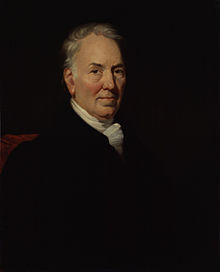Thomas Bewick | |
|---|---|
 Portrait by James Ramsay | |
| Born | c. 11 August 1753 Mickley, Northumberland, England |
| Died | 8 November 1828 (aged 75) |
| Occupations |
|
| Spouse |
Isabella Elliott
(m. 1786; died 1826) |
| Children | 4, including Jane |
Thomas Bewick (c. 11 August 1753 – 8 November 1828) was an English wood-engraver and natural history author. Early in his career he took on all kinds of work such as engraving cutlery, making the wood blocks for advertisements, and illustrating children's books. He gradually turned to illustrating, writing and publishing his own books, gaining an adult audience for the fine illustrations in A History of Quadrupeds.
His career began when he was apprenticed to engraver Ralph Beilby in Newcastle upon Tyne. He became a partner in the business and eventually took it over. Apprentices whom Bewick trained include John Anderson, Luke Clennell, and William Harvey, who in their turn became well known as painters and engravers.
Bewick is best known for his A History of British Birds, which is admired today mainly for its wood engravings, especially the small, sharply observed, and often humorous vignettes known as tail-pieces. The book was the forerunner of all modern field guides. He notably illustrated editions of Aesop's Fables throughout his life.
He is "usually considered the founder of wood-engraving" as "the first to realize its full potentialities",[1] using metal-engraving tools to cut hard boxwood across the grain, producing printing blocks that could be integrated with metal type, but were much more detailed and durable than traditional woodcuts.[1] The result was high-quality illustration at a low price.
- ^ a b Griffiths, Anthony (1996). Prints and Printmaking: an Introduction to the History and Techniques (2nd ed.). British Museum Press. pp. 22–24. ISBN 978-0-7141-2608-1.